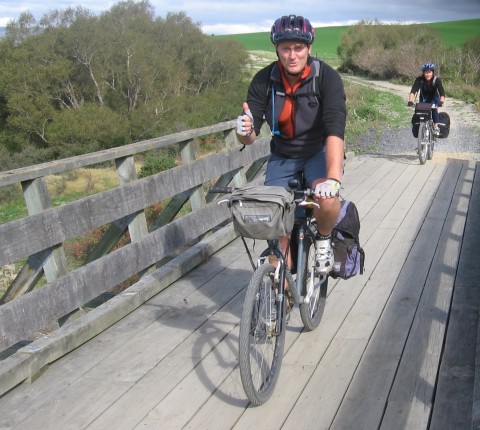
The popularity of the Otago Central Rail Trail shows no signs of waning, despite anecdotal reports of demand dropping or levelling off during the past season.
More than 120 people attended the first workshop on the future of the trail, held at Omakau on Friday, and were told user numbers had increased for the past two years.
The 150km walking and cycling trail from Clyde to Middlemarch is maintained and developed by the Department of Conservation and the Otago Central Rail Trail Trust.
Doc Central Otago manager Mike Tubbs said electronic counters along the trail recorded user numbers. Figures for the use of the whole trail were based on an average over four "remote" locations, where people were likely to travel if they were completing the entire trail.
The number of people using the trail in the year ending June 30, 2010 was 12,157, compared with 10,058 the previous year. In the past seven years, an increase was recorded each year except 2008-09, when the number declined by 880 on the previous year. Mr Tubbs said the most recent figures, until the end of March this year, showed an increase in patronage.
People from throughout Otago attended the forum, with local authorities, trail business operators, tourism and promotion groups, Chamber of Commerce, cycle groups, environmental organisations and service groups all represented. A strategic plan for the future of the trail, based on the feedback at the forum, will be prepared.
Trail trust chairwoman Daphne Hull was delighted at the diversity of groups represented and the views aired.
"I look forward to seeing the report, which will highlight the common ground. The general feeling from the forum was that people are happy with the trail as it is - there was no push to seal it, for example. The next challenge will be promotion and marketing and there's very differing views about who should be responsible for that and how it should be funded."
The trust and Doc fund the maintenance and development of the trail, which costs about $316,600 a year.
Mrs Hull and Mr Tubbs told the forum that although their respective organisations promoted the trail, they did not have a budget for marketing.
"The website is our main marketing tool and our trail passports are another strong promotional tool," Mrs Hull said.The trust funded brochures and publicity material and contributed to the upkeep and ongoing development of the trail but there was a limit to how often it could "go back to funding trusts with our cap in our hands", she said.
Those at the forum were asked about customer service, the positive and negative effects of the trail on the communities along it, marketing and promotion and their long-term vision for the trail.
"It's more than just a bike ride and we need to plan for people to spend some time in the area," Kath Thomas, of Naseby, said. Many at the forum said the aim should be to encourage rail-trail users to stay longer.
Positive effects of the trail included the boost to the economy, the creation of jobs and providing an opportunity for businesses to develop. Negatives included a loss of serenity in some places and the potential for overcrowding.
Concern was expressed about the lack of cellphone coverage at points along the route.
Trail statistics:
• The number of rail trail users (whole trail), year ending June 30, 2010: 12,157
• The number of users five years ago: 8923
• Most popular section of trail: Poolburn Gorge (Lauder to Auripo)
• Number using that section, year ending June 30, 2010: 24,062
• Trail users from July 1, 2010 to March 31 this year: 8347
• Trail users for the same time 2009-10 year: 8148
• Annual maintenance and development cost: $316,612
• Money spent on maintenance and development since inception (17 years): $4.72 million
source: http://www.odt.co.nz/your-town/alexandra/161630/rail-trail-still-proving...
Pic: Omakau resident Stephen Wood , a member of the Cycling Advocates Network, arrives on his bike for the first Otago Central Rail Trail workshop.
